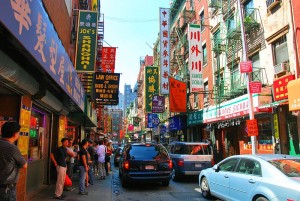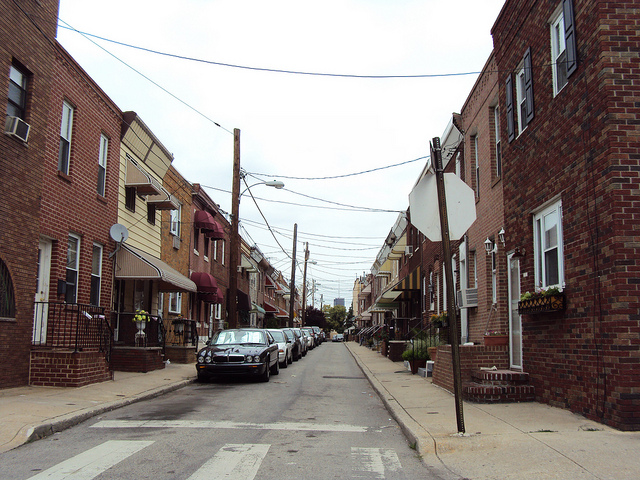When I moved to the St. Louis area in 2005, I rented a townhouse in the inner-ring suburb of Richmond Heights. It was a quiet, safe, and pleasant neighborhood, but rather dull. The neighborhood was entirely residential and abutted a freeway. There was little of interest within walking distance, and as a consequence, the street was deserted the vast majority of the time
I was starting a job at a Missouri think tank, and one of my first projects was the creation of a book club for local college students. I’d been interested in Jacobs ever since I read this Reason interview of her, so I made The Death and Life of Great American Cities one of our first selections.
I enjoyed the book, and after a year in Richmond Heights, I decided I’d like to live in a neighborhood that better fit Jacobs’s theories. I chose St. Louis’s Central West End, which seems to be the closest thing St. Louis has to the high-density, mixed-use neighborhoods Jacobs championed. I lived there for two years, and I’m happy I moved. But it quickly became clear that the CWE falls far short of the urban ideal Jacobs articulated. The CWE is an island of moderately high density in a thoroughly suburban metropolitan area. I could sometimes walk to dinner or the dry-cleaners, but in practice I wound up driving almost everywhere else. There were just too many key amenities outside of a reasonable walking distance.
Last year my wife and I got an apartment the Passyunk Square neighborhood of South Philadelphia, and the difference has been dramatic. Passyunk Square is both much denser than the Central West End and embedded in a much larger cluster of high-density, mixed-use neighborhoods. As a result, there are literally dozens of shops and restaurants within 5 minutes’ walk, including two dozen restaurants, a dozen bars, a reasonably-priced supermarket, half a dozen convenience stores, a hardware store, a comic book shop, various clothing stores, etc. This is dramatically more than what was available near me in the Central West End. The CWE had a healthy assortment of bars and restaurants nearby, but it was sorely lacking in other amenities. The nearest hardware store and convenience stores were 17 and 19 minutes away, respectively, which is far enough away that I’d never actually walk to them.
 Increasing urban density spurs powerful network effects. As the number of residents per square mile in an area goes up, the number of businesses that area can support goes up in proportion. A larger number of nearby businesses, in turn, makes the area more convenient and enjoyable place to live, creating still more demand for housing and (assuming legal barriers don’t prevent it) still higher density. And those additional residents, of course, are potential customers, which attracts still more businesses. The same story can be told of other types of amenities—churches, schools, community theaters, yoga studios, day care centers, pet sitters, and so forth—higher density means more people with whom you might engage in productive activities of all kinds.
Increasing urban density spurs powerful network effects. As the number of residents per square mile in an area goes up, the number of businesses that area can support goes up in proportion. A larger number of nearby businesses, in turn, makes the area more convenient and enjoyable place to live, creating still more demand for housing and (assuming legal barriers don’t prevent it) still higher density. And those additional residents, of course, are potential customers, which attracts still more businesses. The same story can be told of other types of amenities—churches, schools, community theaters, yoga studios, day care centers, pet sitters, and so forth—higher density means more people with whom you might engage in productive activities of all kinds.
And you don’t just get more businesses per square mile, you get different kinds of businesses. The larger pool of potential customers (and the stiffer competition) encourages entrepreneurs to take bigger risks and pursue more niche markets. A tasty one-woman organic grocery store recently opened up shop a few blocks from our apartment in Philadelphia. I don’t know if it will survive, but I do know that it wouldn’t have a chance in the Twin Cities suburb where I grew up.
Best of all, reducing costs can make new services economically viable that weren’t viable before. Clay Shirky has argued that the Sears Catalog, the Amazon.com of the late 19th century, was made possible by the rapidly falling costs of interstate shipping made possible by the railroads. Increasing urban density has a similar effect. For example, in the Twin Cities, where I grew up, it’s almost impossible to hail a cab from the street, because the low density means cabbies would waste too much time waiting for their next customer. In Philly and New York, you can catch a cab almost instantly from any major intersection, because the higher density makes the average wait time between customers manageable. And this sets off a virtuous circle, because once passengers know they can hail cabs from the street, they use more of them, which employs more cab drivers and makes the average wait time even shorter.
This is why it’s frustrating when local governments enact policies explicitly designed to limit urban density. Many municipalities set minimum lot sizes, regulate the height of buildings, require building setbacks, mandate free parking, and take other steps that places a ceiling on urban density. As a result, the densest places in America are almost all cities that achieved that high density before the rise of the automobile and the emergence of the modern regulatory state. Manhattan’s density peaked in 1910, for example. In Western and Southern urban areas regulations have systematically undermined the natural process of increasing density, forcing people instead to spread out horizontally. High-density living isn’t for everyone, but it should be an option in more parts of the country.




Where I live, I’m pretty lucky to be within walking distance of a decent nexus of restaurants and shops, though only compared to the rest of my town (no one from an actual city would consider it a decent amount). They actually highly discourage commercial activity in Shaker Heights, as far as I can tell.
I think you’re definitely right that some people just don’t like high density stuff (obviously those people run my town) but I’d like to see what would happen with less actual restrictions against it.
Great post.
Although I can rationalize density from an opportunistic point-of-view, or even a purely eco(nomic too)-friendly one, I am struggling with the relationship between density and quality-of-life. I don’t want to imply that I _want_ to drive my car – I truly wish I could get away from it. But, there’s something to the inverse of density. It is (probably) true that many western municipalities wanted to grow out – but, I think your assertion that it was caused by city regulations is a bit off-target. Remember most people went west to get away from the density.
I live in Tucson, AZ. Like many places, we have a small bit of the density that you appreciate, and for the same reasons. The concentration allows for the small business diversity that we all appreciate. However, I personally don’t need that, or necessarily want it. My problem is that our city really lacks the quality public transit to link, or even extend that area – which is a regulatory problem. Here in Tucson, the most powerful politicians are the car dealers. So, when it comes down to improving public transportation, or widening roads – well, I’m sure you can figure out what’s happening here.
I think you have to look at what people wanted, and want now – beyond just the governmental structures that help, or hurt the development of an area. Not everyone is up for concentration of population – which is good and bad.
Philly’s interesting to me from a Jacobs-perspective because, while being much denser than a city like St. Louis, it’s significantly less dense than New York. A five-story tenement in NYC takes up maybe four-times the space of a Philly rowhouse but holds 10 or 20 times the population. And the gentrification of Philly’s rowhome neighborhoods has led to even lower density — two people living in a building that was built for five or six.
Great post Tim. This is one of my favorite topics.
I think you hit on the real culprit. These days, it would matter if people wanted to create places like the one you live in in South Philly — the zoning laws in most cities prohibit them. And the issue is usually parking. In order to build any building for commercial use the builder is responsible for providing ample parking, and the laws of nature make it impossible to achieve the type of environment you enjoy in Philly (so much space being taken up by cars).
If anyone’s interested, a great person to read on this topic is James Howard Kunstler. His book “The Geography of Nowhere” is considered a classic in this area. He’s a strong advocate for taking away considerations for cars when building our physical environment, and focusing on creating habitats for human beings.